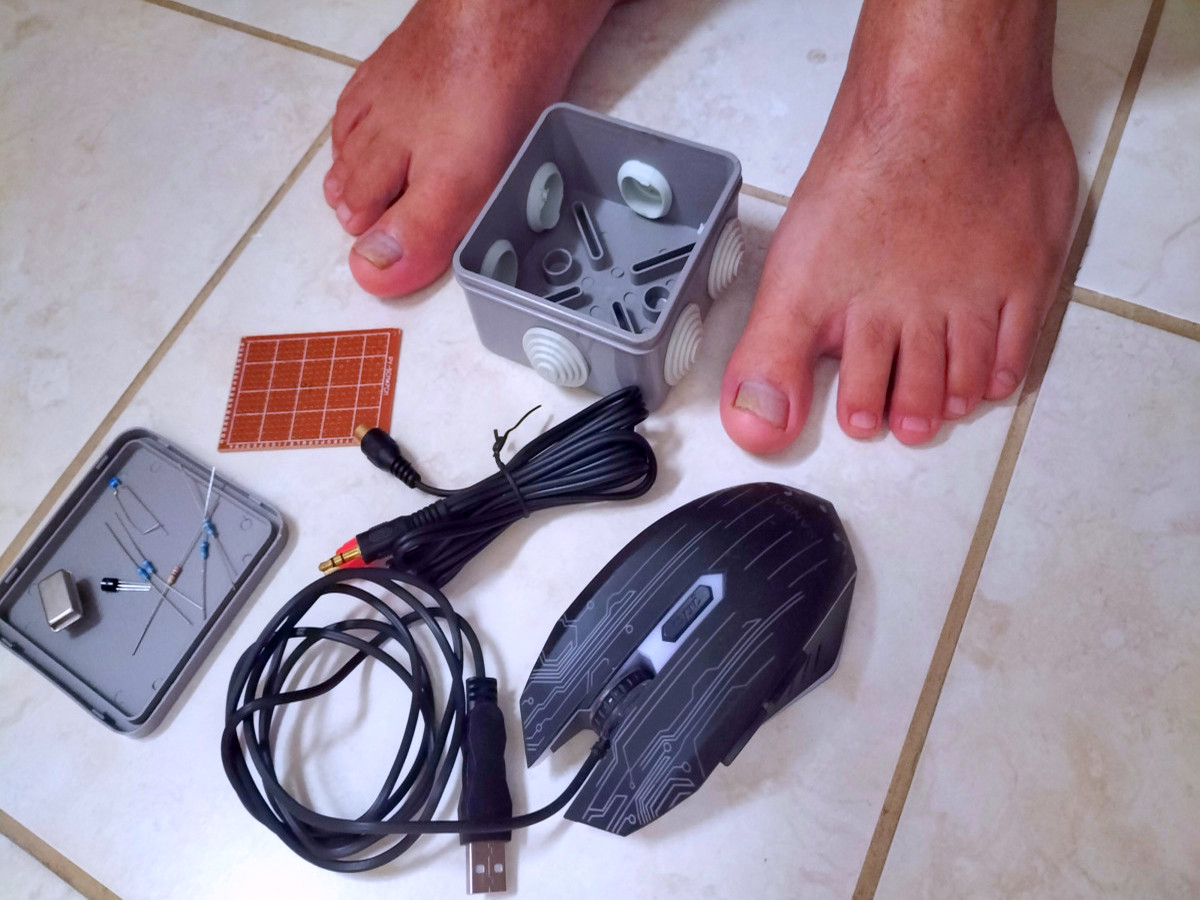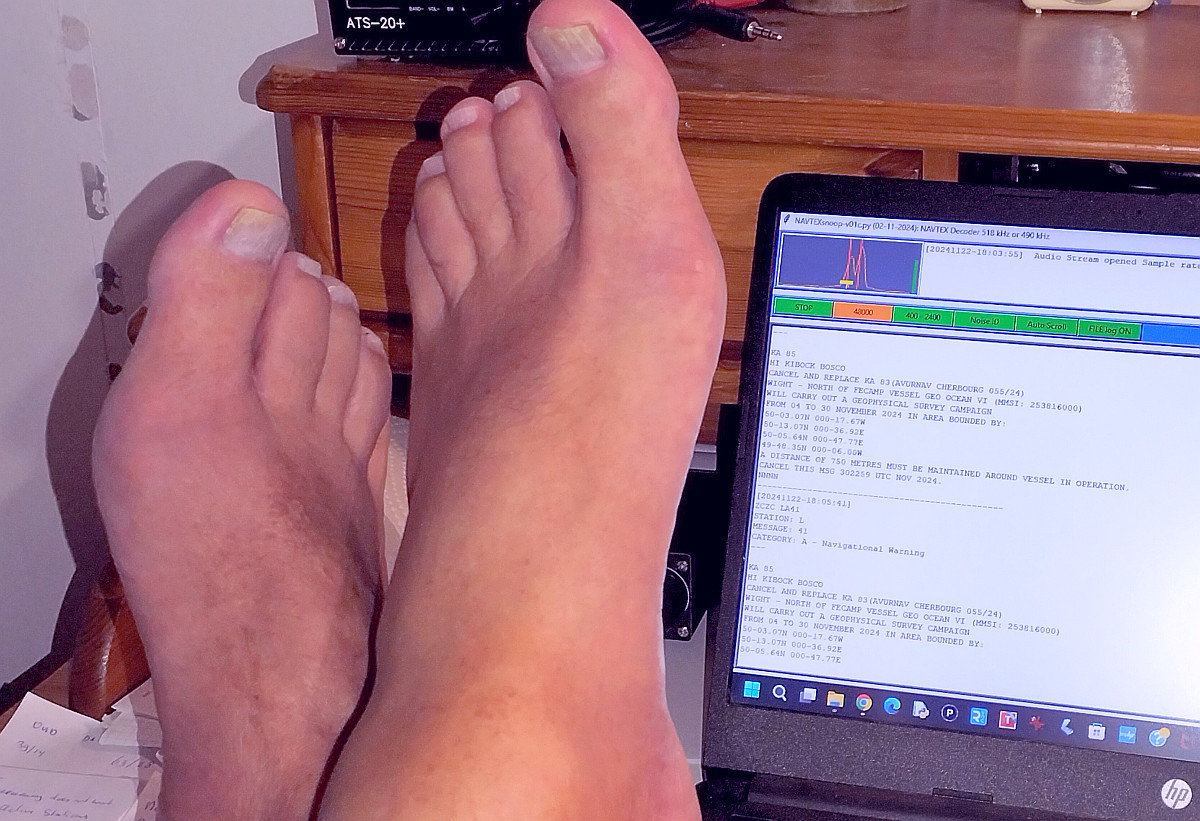NAVTEX TEST TRANSMITTER BY...
THE BAREFOOT NAVTEX NERD!
(2025)

The barefoot Navtex Nerd has to make a very simple Navtex test transmitter!
Some important parts and... his way too cold purple-red toes!
NAVTEX test transmitter by the barefoot Nerd
The barefoot Navtex Nerd promised George to make a very simple and cheap Navtex test transmitter for him!
But it is winter and the Nerd has to go barefoot on the ice cold floor of his workshop! Shoes, socks and carpets are forbidden because of static electricity!
Only 8C in the workshop and an ice cold tiled concrete floor! Impossible!!! Nobody can walk barefoot on such a cold floor!!!! However, the barefoot Navtex Nerd had promised it. He finally agreed, athough he will have ice cold bare feet with way too cold suffering toes during many weeks! Let's hope that the barefoot Navtex Nerd his toes will be able to survive the way too cold tortures so that we can see how he will make that simple Navtex transmitter!

A very simple diagram, a very simple solution!
How it works
A Navtex test signal with an audio frequency of 18 kHz is made with NAVTEXtest.py software. This audio WAV file is played with the audio player of the PC.
This 18 kHz signal is mixed with 500 kHz so that you get a Navtex radio signal of 500 + 18 = 518 kHz.
The 500 kHz oscillator switches the FET BS170 on and off. In this way it works as a HF mixer.
The 27 ohm resistor and 0.1 uF capacitor are a filter for the supply voltage and the 27 ohm resistor also acts as a fuse if there is something wrong in the circuit...
The signal is very weak, the range is only a few meters, so only within your house. It will not cause any interference with the official Navtex transmissions.
Connect a wire to the output and wrap that wire around the receiver's Navtex antenna. Then the signal is strong enough to activate the Navtex receiver!
490 kHz
You can also generate a Navtex signal of 490 kHz. Then a Navtex test signal with an audio frequency of 10 kHz is made with NAVTEXtest software.
This 10 kHz signal is mixed with 500 kHz so that you get a Navtex radio signal of 500 - 10 = 490 kHz.

The 500 kHz oscillator module can be purchased at a webshop for only a few euros
The most important part is the 500 kHz oscillator module!
The most important part is the 500 kHz oscillator module. You can order it for a few euros from an online store. It has an accuracy of 20 ppm, that is 10 Hz at 500 kHz. That is accurate enough, so you know for sure that the frequency is correct!
And you need an USB cable. It is only used for the supply power of 5 volt. Cut off the unused connector and use only the red (+) and black (-) wires. As you can see, I used the USB cable from an old broken mouse.
And you need an audio cable. I bought it from a Chinese store. A 3 mm plug on one side and two cinch plugs on the other side. Cut off the cinch plugs with 0.5 meters of wire. The 3 mm plug is the connection with the audio output of your PC. Use the wire that is connected to the top pin.
And one of the remaining pieces of wire with red cinch plug is used for the 518 kHz HF output of the Navtex transmitter.
Everything is mounted on a perforated board in a cheap mounting box for electrical cables.

Far too cold suffering toes on the way too cold tiled concrete floor but... Ready!
The construction is simple!
The barefoot Navtex Nerd looks at his horribly cold bare feet on the much too cold tiled concrete floor. His toes are absolutely not resistant to the extreme cold and have scary purple-red colors. Unbelievably, he still hasn't suffered any damaged toe joints!
After a few weeks, the Nerd has a great design! Oh, you can guess it, his first idea was also the best! A new challenge! Also the construction has to be simple! The Barefoot Navtex Nerd complains about his ice cold toes. But George encourages the Barefoot Navtex Nerd to continue with the project! George also wants to see how long the ice cold suffering toes of the barefoot Navtex Nerd will be able to survive the horrible cold! The Barefoot Navtex Nerd finally agrees... Despite his suffering cold toes with scary purple-red colors, he's going to make that simple "thing". After all, he promised that!

Top side of the perforated board
How to operate the simple Navtex Test Transmitter
Connect the audio to the headphones output of your PC and the USB cable to a free USB port. Connect 1 meter wire to the HF output and wrap it around the antenna of the Navtex receiver
Play the WAV file made by the NAVTEXtest.py software with the audio player of your PC and the message should be displayed. The audio pitch of the WAV test message should be set to 18 kHz. Set the volume to an average level.

Bottom side of the perforated board
Again!
Yes, the barefoot Navtex Nerd did it again! A really simple circuit! The Barefoot Navtex Transmitter! Barefoot for weeks on the incredibly cold stone floor! Amazing, it was far too cold for his toes, yet his horribly cold toes barely survived! And then there is that exciting moment, finally the Navtex receiver receives the simple Navtex test transmitter!

Yes, the barefoot Navtex Nerd did it again! Barefoot for weeks on the way too cold stone floor!
And then there is that exciting moment, finally the Navtex receiver receives the simple Navtex test transmitter!
NAVTEXtest.py software
The NAVTEXtest.py software is written in Python.
But you have to change the standard pitch of 1500 Hz of the Navtex signal, press the configuration button and:
For 518 kHz: SL17915 and SH18085
For 490 kHz: SL10085 and SH9915 (indeed, upper and lower shifts exchanged because 490 kHz is lower than 500 kHz)
You can find the NAVTEXsnoop.py software by clicking the following link:
LINK TO NAVTEXtest.py TO MAKE NAVTEX TEST MESSAGES
The simple Navtex Test Transmitter project is a success!
Barefoot on the ice cold tiled floor of his workshop to prevent static electricity was really way too difficult and too dangerous for the vulnerable toes of the barefoot Navtex Nerd! His suffering toes barely survived the horrific cold! But... the suffering of his far too cold toes is rewarded with success! He's already looking forward to the next challenging Navtex project, barefoot again on that far too cold stone floor!
However, there are a few remarks...
The transmitter also transmits on 500 - 18 = 482 kHz. And even a stronger signal at 500 kHz. But the signals are so weak that they are harmless. It is illegal and also impossible to connect this simple transmitter to an amplifier. Impossible because the 500 kHz signal will overload such an amplifier. It is only possible to use it as a low level harmless test generator, not a real Navtex transmitter!
Index PA2OHH







